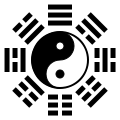This article needs additional citations for verification. (December 2015) |
| Part of a series on |
| Taoism |
|---|
 |
Taiyi Shengshui (Chinese: 太一生水; pinyin: Tàiyī Shēngshuǐ; lit. 'The Great One Gave Birth to Water') is an ancient Chinese text from around 300 BC during the Warring States period. It was discovered as part of the Guodian Chu Slips.
It is a Taoist creation myth. According to the transcription and translation by professors Wen Xing and Robert G. Henricks of Dartmouth College, the opening lines are:
太一生水, 水反輔太一, 是以成天。天反輔太一,是以成地。 天地(復相輔)也, 是以成神明。 神明復相輔也, 是以成陰陽。[1]
The Great One (Taiyi) gave birth to water. Water returned and assisted Taiyi, in this way developing heaven. Heaven returned and assisted Taiyi, in this way developing the earth. Heaven and earth [repeatedly assisted each other], in this way developing the "gods above and below." The "gods above and below" repeatedly assisted each other, in this way developing Yin and Yang.[2]: 123
The Taiyi Shengshui was written on 14 bamboo strips and was discovered among the Guodian Chu Slips in 1993 in Hubei, Jingmen, and has not been discovered anywhere else.[3] The text's inclusion in the Guodian "Laozi C" bundle has led some scholars to suggest it may have been considered part of the Tao Te Ching.[4][2]: 8
References
[edit]- ^ Xing, Wen (邢文), trans. & ed. (July 2005). 郭店老子與太一生水 Guodian Laozi & Taiyi shengshui(in Chinese) (1 ed.). Beijing: Academy Press 學苑出版社. p. 232. ISBN 7-5077-2587-1.
- ^ a b Henricks, Robert G. (2000). Lao Tzu's Tao Te Ching (1 ed.). New York: Columbia University Press. ISBN 0-231-11816-3.
- ^ Murphy, Dan (2006). A comparison of the Guodian and Mawangdui Laozi texts (M.A. thesis). Amherst: University of Massachusetts Amherst. p. 6. doi:10.7275/6870785.
- ^ Brindley, Erica (2019), Chan, Shirley (ed.), "The Taiyi shengshui 太一生水 Cosmogony and Its Role in Early Chinese Thought", Dao Companion to the Excavated Guodian Bamboo Manuscripts, Dao Companions to Chinese Philosophy, Cham: Springer International Publishing, pp. 153–162, doi:10.1007/978-3-030-04633-0_8, ISBN 978-3-030-04633-0, retrieved 2024-01-02
